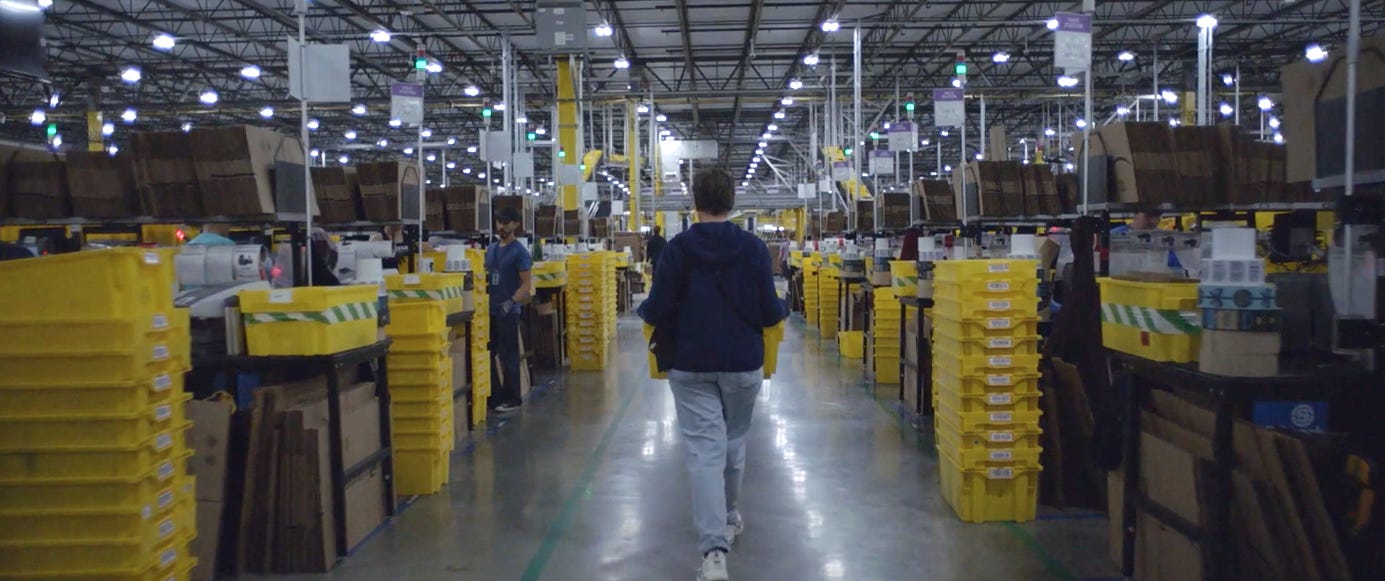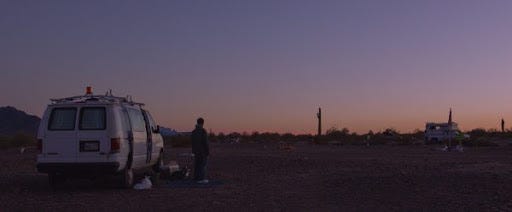Welcome to postcapitalist phantasies: put me into another world, where I’ll be looking to artists and thinkers who are offering a way out of the hyper-capitalist hell we find ourselves in. ‘Put me into another world’ is stolen from Mark Fisher and Judy Thorne’s conversation on luxury communism in Futures and Fictions: “even beginning to think about what luxury communism might mean starts to unglue the habituated patterns of thought established by capitalist realism; it makes demands on the imagination, it already puts us into another world”. Mark was one of my tutors at Goldsmiths and caused a profound shift in my thinking. I’d entered his classes definitely naive and probably pessimistic. My encounters with him were brief but I’ll forever be inspired by his belief that the possibility for change was always on the horizon.
I spent the last Bank Holiday Monday evening watching Chloe Zhao’s Nomadland with my boyfriend who lives amongst tower blocks in Manchester’s city-centre. The weather that day was vile; the rain so heavy we became trapped in the concrete sky. When Manchester is sunny, it transforms into my favourite place and I can’t shake off my nostalgia for it. It’s where I went to university, where I met my boyfriend, and a city I regularly visited throughout my life, with family dotted in towns nearby. The sun melts away the grievances I had with it, which are grievances with my past self. I was gripped with anxiety and OCD during those early university years and fought with an underfunded healthcare system and overburdened university mental health support system, desperate to get any treatment. Moving to London in 2015, I traded my anxiousness for depression. The latter I’m still trying to shake off.
We hit play on Nomadland. It’s a film about ‘houseless’ communities who travel around the US, supporting their nomadic lifestyles through the gig economy and has been heralded as a “Portrait of Modern America.” I had read zero reviews and zero Twitter takes due to a self-imposed social media ban (for my well being). Will tells me that the film has been lauded for its use of ‘normal’ people, so we naturally spend the rest of it trying to figure out who’s real, who isn’t, and debating how Francis McDormand got a nomad to fall in love with her. Turns out, the ‘real’ people are fictionalised versions of themselves and the romance was a hoax (he was the only professional actor). However, one thing that we knew was real from the start and that opens and closes the film: the Amazon warehouse.
It’s generally difficult to disentangle Amazon with its reputation: an extractive corporation that doesn’t pay enough tax, treats its workers horrifically, profits off a global pandemic and is the creator of an invasive facial surveillance technology to monitor its staff, which has subsequently been sold to the U.S. Immigration and Customs Enforcement. The film has been criticised for sidestepping these issues, which had been highlighted in the book it is based on, Jessica Bruder’s Nomadland: Surviving America in the Twenty-First Century.
The film opens with an Amazon warehouse, a monolithic figure towering in a vacant landscape. Fern (McDormand), the protagonist who the film follows, enters for her shift, scanning and sorting packages. She has a pleasant lunch in the canteen with her colleagues; one is a fellow nomad and tells Fern to come to a vandweller meet-up in the desert organised by Bob Wells, an influential figure within the community. She initially declines, but freezing weather conditions and not enough money to keep her van (and herself) warm encourage her to drive to the gathering. The film swiftly moves on and Amazon is forgotten about.
Visually, the film was beautiful: the landscape shots were luscious and wide-spanning. Maybe the northern rain made us crave the escapism to this endless land; the orange and pink skies were seductive; the cool glassy lakes were inviting us to dip our toes in; dulcet piano tones soundtracked our travels. It’s a classic road trip movie with an accompanying journey of self-discovery. Fern moves through personal grief whilst she drives across the American landscape, picking up seasonal jobs and making friends in a nomadic community, who seemingly drift apart and then back together, seeing each other ‘back down the road’, prophesies Bob Wells.
I was so hypnotised by its dreamy aesthetic and McDormand’s tender performance that I failed to switch my brain on. Tricked into loving Amazon by proxy, my critical eye had been blinded. The next day, having read through these criticisms, I thought to myself: I agree, but could an argument be made for subtlety. Fern’s incapacity to afford to move her van into a different area despite temperatures dropping to dangerous levels when she had a job at Amazon highlighted, for me, capitalism failing. As did this community of people who have opted out of ‘mainstream’ society (e.g. in one scene, a nomad talks about their previous life as a banker), choosing to adopt a nomadic lifestyle is inherently anti-capitalist.
Mark Fisher defines capitalist realism as: “the widespread sense that not only is capitalism the only viable political and economic system, but also that it is now impossible even to imagine a coherent alternative to it.” It has become such a naturalised part of our landscapes that we can’t see life without it. Nomadland naturalisesAmazon’s warehouse, assimilating it into an inevitable part of Fern’s physical and psychic landscape. Its looming presence bookends the film, looping us back through an infinite life cycle. Fern is trapped in a precarious gig economy, tied to wage labour. Her world cannot be imagined without Amazon, and neither can ours.
—————————————————————————————————————
Some other interesting Amazon articles:
Paris Marx makes a case for nationalising Amazon here.
Drew Austin’s ‘The Constant Consumer’ asks: “The customer role used to be temporary and specific — buying something from a seller — and not an aspirational identity. What happened?”




